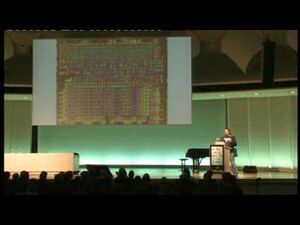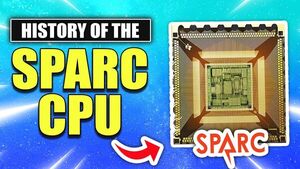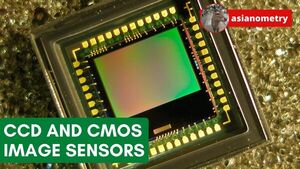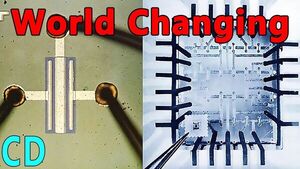2023-03-30 - Nº 413
Editorial
Esta é a Newsletter Nº 413 que se apresenta com o mesmo formato que as anteriores. Se gostar da Newsletter partilhe-a!
Todas as Newsletters encontram-se indexadas no link.
Esta Newsletter tem os seguintes tópicos:
Faz hoje anos que nascia, em 1674, o escritor e agrónomo inglês Jethro Tull. Ele inventou uma sementeira movida a cavalo por volta de 1701. Ele promoveu a sementeira em filas em vez de a transmitir (lançando simplesmente as sementes em redor), para que as ervas daninhas pudessem ser controladas através da enxada regular entre as filas. Para este fim, concebeu a sua sementeira, que podia plantar três filas ao mesmo tempo. Uma lâmina cortou uma ranhura no solo para receber a semente, e o solo foi virado para cobrir a semente. Uma tremonha distribuiu uma quantidade regulada de sementes. Por causa das partes móveis internas, foi chamada a primeira máquina agrícola. O seu mecanismo rotativo tornou-se parte de todos os dispositivos de sementeira que se seguiram. Tull também inventou um arado de quatro arados para fazer cortes verticais no solo antes do arado.
Faz também hoje anos que nascia, em 1811, o químico alemão Robert Bunsen. Ele investigou espectros de emissão de elementos aquecidos, e descobriu césio (em 1860) e rubídio (em 1861) com o físico Gustav Kirchhoff. O Prémio Bunsen-Kirchhoff para espectroscopia tem o nome de Bunsen e Kirchhoff. Bunsen também desenvolveu vários métodos gasanalíticos, foi pioneiro na fotoquímica, e fez um trabalho precoce no campo da química do arsénico orgânico. Com o seu assistente de laboratório Peter Desaga, desenvolveu o queimador de Bunsen, uma melhoria em relação aos queimadores de laboratório então em uso.
Faz igualmente hoje anos que nascia, em 1862, o matemático britânico Leonard James Rogers. Ele foi o primeiro a descobrir a identidade Rogers-Ramanujan e a desigualdade de Hölder, e que introduziu os polinómios Rogers. Os polinómios Rogers-Szegő têm o seu nome em sua homenagem.
Faz também hoje anos que nascia, em 1879, o óptico-optometrista estónio Bernhard Voldemar Schmidt. Ele inventou o telescópio que lhe deu o nome. Em 1929, concebeu um novo sistema de espelhos para reflectir telescópios que superou problemas anteriores de aberração da imagem. Utilizou um vácuo para aspirar o vidro para dentro de um molde, polindo-o achatado, permitindo depois que voltasse a ganhar forma. O telescópio Schmidt é agora amplamente utilizado em astronomia para fotografar grandes secções do céu, devido ao seu grande campo de visão e à sua fina definição de imagem. Perdeu o braço quando era criança enquanto experimentava explosivos. Schmidt passou o último ano da sua vida num hospital psiquiátrico.
Faz igualmente hoje anos que nascia, em 1886, o lógico e matemático polaco Stanislaw Lesniewski. Ele co-fundou a escola de lógica de Varsóvia, que floresceu entre as Guerras Mundiais na Polónia. Como seu principal representante, juntou-se a Alfred Tarski (então seu aluno de doutoramento), e a Jan Łukasiewicz na Universidade de Varsóvia, tornando-a talvez o principal centro de investigação de lógica formal do mundo. A sua abordagem aplicou o máximo rigor na formalização e execução da lógica. Com ideias originais, concebeu os três sistemas formais, agora conhecidos como prototéticos, ontologia, e meraologia, como uma alternativa concreta para estabelecer a teoria. Embora no início menos conhecido internacionalmente, os seus ensinamentos universitários influenciaram os matemáticos polacos subsequentes.
Faz também hoje anos que nascia, em 1891, o engenheiro e fabricante norte-americano Arthur William Sidney Herrington. Ele desenvolveu uma série de veículos militares, o mais conhecido dos quais foi o jipe da Segunda Guerra Mundial. Durante a Primeira Guerra Mundial, começou a trabalhar num novo desenho de camiões militares para terrenos acidentados, o mais pequeno dos quais era o jipe de um quarto de tonelada com tracção às quatro rodas que se tornou o protótipo de vários modelos construídos nas décadas de 1930 e 1940. O jipe serviu na II Guerra Mundial como porta-cama, suporte de metralhadora, veículo de reconhecimento, pickup truck, limusina da linha da frente, portador de munições, camada de arame e táxi.
Faz igualmente hoje anos que nascia, em 1892, o matemático polaco Stefan Banach. Ele fundou a análise funcional moderna e ajudou a desenvolver a teoria dos espaços vectoriais topológicos. Além disso, contribuiu para medir a teoria, a integração, a teoria dos conjuntos, e as séries ortogonais. Na sua dissertação, escrita em 1920, ele definiu axiomaticamente o que hoje se chama um espaço Banach. A ideia foi introduzida por outros mais ou menos ao mesmo tempo (por exemplo, Wiener introduziu a noção mas não desenvolveu a teoria). O nome 'Espaço Banach' foi cunhado por Fréchet. Banach algebras também recebeu o seu nome. A importância da contribuição de Banach é que ele desenvolveu uma teoria sistemática de análise funcional, onde antes só se tinham obtido resultados isolados que mais tarde foram vistos como encaixando na nova teoria.
Por fim, faz hoje anos que nascia, em 1894, o desenhador de aviões soviético Sergey Vladimirovich Ilyushin. Ele criou o famoso avião de ataque blindado Il-2 Stormovik, o avião mais utilizado e mais produzido durante a Segunda Guerra Mundial pela Força Aérea da União Soviética. Após a guerra, trabalhou durante pouco tempo em aviões a jacto bombardeiros e concebeu um dos aviões de maior sucesso da época, o Il-28. Na década de 1950 deixou de trabalhar em aviões de guerra e concentrou os seus estudos em aviões de passageiros e de transporte movidos a turbopropulsor e turbo-jacto. Os aviões civis que concebeu incluem: o avião de passageiros bimotor Il-12 (1946), o transporte a turbopropulsor a quatro motores Il-18 Moskva (1957), o transportador de passageiros turbo-jacto Il-62 (1962), e o airbus Il-86, que fez o seu primeiro voo em 1976.
Em 1791, após uma proposta da Académie des sciences (Borda, Lagrange, Laplace, Monge e Condorcet), a Assembleia Nacional francesa escolheu finalmente que um metro seria um 1/10 000 000 da distância entre o pólo norte e o equador.
Em 1950, foi anunciada a invenção do fototransistor, operado por luz e não por corrente eléctrica. Foi inventado pelo Dr. John Northrup Shive of Bell Telephone Laboratories, Murray Hill, N.J. A ponta de um único fio colector repousa sobre uma pequena covinha de terra num dos lados de um minúsculo chip de germânio, um material semicondutor. Nesta altura, o disco de germânio tem apenas 0,003 polegadas de espessura. Quando montado no interior de um minúsculo cilindro com ponta de comprimento, a luz focada no lado oposto, sem covinhas do disco, controlava o fluxo de corrente no fio. A sua função era semelhante, mas convenientemente mais pequena do que uma célula fotoeléctrica.
Na Newsletter desta semana apresentamos diversas noticias, artigos científicos, projetos de maker e alguns vídeos interessantes. São apresentadas as revistas MagPI nº 128 e a HackSpace Magazine Nº 65 de Abril.
 João Alves ([email protected])
João Alves ([email protected])
O conteúdo da Newsletter encontra-se sob a licença  Creative Commons Attribution-NonCommercial-ShareAlike 4.0 International License.
Creative Commons Attribution-NonCommercial-ShareAlike 4.0 International License.
Novidades da Semana
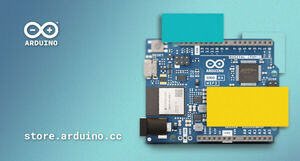
Arduino UNO R4 is a giant leap forward for an open source community of millions
"Here at Arduino we are thrilled to announce a new, revolutionary revision of the iconic UNO board, which will expand the concept of the open-source brand’s most iconic and popular product while providing the maker community with a long-awaited update on performance and possibilities. The Arduino UNO R4 indeed preserves the well-known features of the UNO family – standard form factor, shield compatibility, 5V operating voltage, outstanding robustness – while offering no less than a 32-bit Cortex®-M4 and a 3-to-16x increase in clock speed, memory and flash storage. This huge leap forward starts with a new processor by Renesas, a global leader in microcontrollers, analog, power and SoC products. While over 10 million users have enjoyed playing and working with Arduino UNO R3’s 8-bit microcontroller for more than a decade, the new RA4-series MCU will open up endless new project opportunities for more advanced makers, and bring the board up to speed with current standards. The UNO R4 will come in two versions – UNO R4 WiFi and UNO R4 Minima – offering unprecedented performance and possibilities for the maker community. The WiFi version comes with an Espressif S3 WiFi module, expanding creative opportunities for makers, educators, and hobbyists alike; while the UNO R4 Minima provides a cost-effective option for those seeking the new microcontroller without additional features." [...]
Outras Notícias
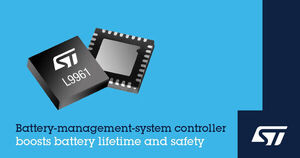
STMicroelectronics makes lithium batteries perform better and last longer with high-accuracy BMS controller
"STMicroelectronics’ L9961 battery-management-system (BMS) device provides market-leading accuracy and flexibility to enhance the performance, lifetime, and safety of Li-ion and Li-polymer batteries. Suitable for battery packs up to 25V, the L9961 provides monitoring, balancing, and protection of batteries for diverse applications requiring the high energy density of lithium batteries. Cordless power tools, backup energy-storage systems, uninterruptible power supplies, portable and semi-portable equipment, and medical devices can benefit from the L9961’s advanced features. The many built-in features include a dual pre-driver for controlling battery-pack safety relays, which can be programmed for high-side and low-side connection. An embedded non-volatile memory for configuration data relieves the microcontroller from reprogramming the device at each startup. An I2C interface handles configuration and host communication to share battery state-of-charge (SOC) and state-of-health (SOH)." [...]
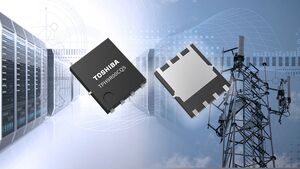
Toshiba Releases 150V N-channel Power MOSFET with Industry-leading Low On-resistance and Improved Reverse Recovery Characteristics that Help Increase the Efficiency of Power Supplies
"Toshiba Electronic Devices & Storage Corporation ("Toshiba") has launched a 150V N-channel power MOSFET “TPH9R00CQ5,” which uses the latest[2] generation U-MOSX-H process, for switching power supplies of industrial equipment, such as that used in data centers and communications base stations. Shipments start today. TPH9R00CQ5 features an industry-leading[1] low drain-source On-resistance of 9.0mΩ (max), approximately a 42% reduction from Toshiba’s existing product, “TPH1500CNH1[3].” Compared with Toshiba’s existing product “TPH9R00CQH[4],” the reverse recovery charge is reduced by about 74% and the reverse recovery[5] time by about 44%, both key reverse recovery characteristics for synchronous rectification applications. Used in synchronous rectification applications[6], the new product reduces the power loss of switching power supplies and helps improve efficiency. Furthermore, compared to TPH9R00CQH, the new product reduces spike voltage generated during switching, helping lower the EMI of power supplies. The product uses the popular, surface-mount-type SOP Advance(N) package." [...]

Renesas Expands RISC-V Embedded Processing Portfolio with New Voice-Control ASSP Solution
"New RISC-V ASSP Allows Industrial and Consumer Electronics Designers to Quickly and Cost Effectively Differentiate Applications with Voice Recognition. Renesas Electronics Corporation (TSE: 6723), a premier supplier of advanced semiconductor solutions, today extended its industry-leading RISC-V portfolio with the first RISC-V MCU designed for voice-controlled HMI (human-machine interface) systems. The new R9A06G150 32-bit ASSP, developed in collaboration with RISC-V ecosystem partners, provides a complete, cost-effective, production-ready voice-control system solution that eliminates the need for RISC-V tools and upfront software investment. Targeting residential and commercial building automation, home appliances, toys and healthcare devices, the new ASSP supports multiple languages and user-defined keywords for voice-recognition operations. The foundation of a turnkey voice-control solution, the R9A06G150 is pre-programmed using specialized application code developed by independent design houses with a proven ability to bring customer designs to volume production. The introduction reinforces Renesas as a leader in the emerging market for the open-source RISC-V ISA (instruction set architecture) and follows introductions last year of a 32-bit motor-control ASSP and 64-bit general-purpose RZ/Five MPUs based on a 64-bit RISC-V CPU." [...]
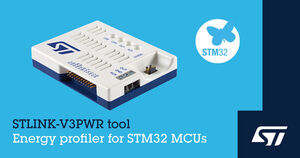
STMicroelectronics reveals STM32 programming/debug probe with extended power-measurement range, enabling next-generation ultra-low-power applications
"STMicroelectronics’ STLINK-V3PWR is a new in-circuit debugging and programming probe that provides accurate power measurement suitable for applications running on any STM32 microcontroller (MCU). Having a wide dynamic range to handle power-conscious projects including IoT and wireless applications, the probe measures current values from nanoamps to 500mA and remains accurate up to ±0.5%. Also, it can supply up to 2A to the target system through a single USB cable, enabling developers to power the board without a separate supply. STLINK-V3PWR is supported directly within the STM32CubeMonitor-Power graphical tool, which helps visualize the power demands of the application in real-time and analyze the effects of design changes to improve energy efficiency. It is also supported within the Arm® Keil® development tool and IAR integrated development environment (IDE), which enable users to synchronize code execution with energy-consumption measurements to optimize the application energy profile. “Ultra-low-power microcontroller applications use energy harvesting or run for years on batteries, however small design errors can create unexpected power issues,” said Reinhard Keil, senior director, embedded technology at Arm." [...]
Ciência e Tecnologia

Ultrasmall swirling magnetic vortices detected in iron-containing material
"A multi-institutional team discovered surprising properties in a magnetic material. This discovery could be applicable to information storage, such as computer memory and high-efficiency microelectronics. Microelectronics forms the foundation of much modern technology today, including smartphones, laptops and even supercomputers. It is based on the ability to allow and stop the flow of electrons through a material. Spin electronics, or spintronics, is a spinoff. It is based on the spin of electrons, and the fact that the electron spin along with the electric charge creates a magnetic field." [...]

Where does the Higgs boson come from?
"The discovery of the Higgs boson at the Large Hadron Collider (LHC) in 2012 was a triumph of theoretical and experimental physics, yet its implications are only just beginning to be understood. Precise measurements by the ATLAS and CMS collaborations show that this fundamental particle, which is responsible for generating the masses of elementary particles, behaves as predicted by the half-century-old Standard Model of particle physics. But where does the Higgs boson come from? And why is it so light that the LHC is able to produce it in droves? Such conundrums were discussed during a week-long workshop, Exotic Approaches to Naturalness, hosted by the CERN Theoretical Physics department from 30 January to 3 February. The Higgs boson is the simplest known particle: a “fragment of vacuum” with no charge or spin." [...]
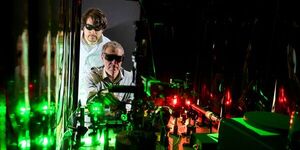
Nanophysics: the right twist
"Stacked layers of ultrathin semiconductor materials feature phenomena that can be exploited for novel applications. A team led by LMU physicist Alexander Högele has studied effects that emerge by giving two layers a slight twist. Novel, ultrathin nanomaterials exhibit remarkable properties. If you stack individual atomically thin layers of crystals in a vertical assembly, for example, fascinating physical effects can occur. For instance, bilayers of the wonder material graphene twisted by the magic angle of 1.1 degrees may exhibit superconductivity. And researchers are also focusing their attention on bilayer semiconducting heterostructures made of so-called transition metal dichalcogenides, which are held together weakly by van der Waals forces." [...]
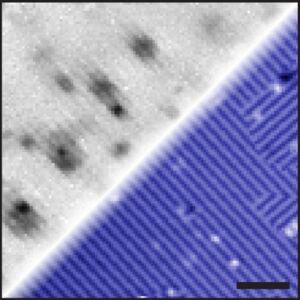
Imaging technique reveals electronic charges with single-atom resolution
"New scanning tunneling microscopy method demystifies what electrons are doing on the surface of a compound. Materials typically conduct electricity or insulate against it – so experimental and theoretical physicists have been captivated by a compound called samarium hexaboride (SmB6) that appears to do both. Numerous studies over the course of 50 years have revealed that SmB6 acts like an insulator as well as an electricity-conducting metal. Now, researchers from the Harvard John A. Paulson School of Engineering and Applied Sciences (SEAS) say it’s possible to image the exact position of electrons along the surface of SmB6 with single-atom precision, enabling a breakthrough in understanding the compond’s properties and why it can both insulate and conduct. The findings, published in Science, build upon SEAS research reported in 2019 that determined that SmB6 is a topological insulator – meaning it conducts electricity along its surfaces but not its insides. Despite the 2019 discovery about SmB6’s surface metallicity, many questions remained about its overall metallicity and why different measurements didn’t generate consistent results." [...]
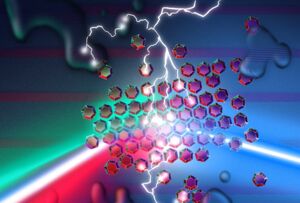
1 device, 2 functions: A laser and an LED
"Lab researchers drive colloidal quantum dot lasing technology closer to device-ready A Los Alamos National Laboratory team has overcome key challenges toward technologically viable high-intensity light emitters based on colloidal quantum dot technology, resulting in dual-function devices that operate as both an optically excited laser and a high-brightness electrically driven light-emitting diode (LED). As described in the journal Advanced Materials, this advance represents a key milestone towards an electrically pumped colloidal quantum dot laser or a laser diode, a new type of devices whose impact would span across numerous technologies including integrated electronics and photonics, optical interconnects, lab-on-a-chip platforms, wearable devices and medical diagnostics. “A quest for colloidal quantum dot laser diodes represents part of a worldwide effort aimed at realizing electrically pumped lasers and amplifiers based on solution-processable materials,” said Victor Klimov, a scientist in Los Alamos’s Chemistry division and the team leader on the research. “These devices have been pursued for their compatibility with virtually any substrate, scalability and ease of integration with on-chip electronics and photonics including traditional silicon-based circuits.” As in a standard LED, in the team’s new devices, the quantum dot layer acted as an electrically actuated light emitter. However, due to extremely high current densities of more than 500 ampere per square centimeter, the devices demonstrated unprecedented levels of brightness of more than a million candela per square meter (candela measures luminous power emitted in a given direction). This brightness makes them well-suited for applications such as daylight displays, projectors and traffic lights." [...]
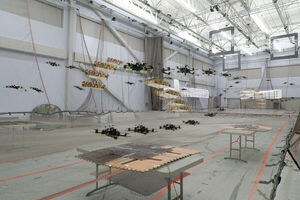
New algorithm keeps drones from colliding in midair
"Researchers create a trajectory-planning system that enables drones working together in the same airspace to always choose a safe path forward. When multiple drones are working together in the same airspace, perhaps spraying pesticide over a field of corn, there’s a risk they might crash into each other. To help avoid these costly crashes, MIT researchers presented a system called MADER in 2020. This multiagent trajectory-planner enables a group of drones to formulate optimal, collision-free trajectories. Each agent broadcasts its trajectory so fellow drones know where it is planning to go. Agents then consider each other’s trajectories when optimizing their own to ensure they don’t collide." [...]
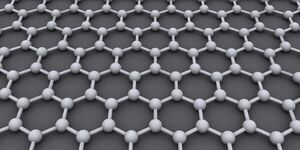
Graphene grows – and we can see it
"Graphene is the strongest of all materials. On top of that, it is exceptionally good at conducting heat and electrical currents, making it one of the most special and versatile materials we know. For all these reasons, the discovery of graphene was awarded the Nobel Prize in Physics in 2010. Yet, many properties of the material and its cousins are still poorly understood – for the simple reason that the atoms they are made up of are very difficult to observe. A team of researchers from the University of Amsterdam and New York University have now found a surprising way to solve this issue. Two-dimensional materials, consisting of a hyper-thin single layer of atomic crystal, have attracted a lot of attention recently." [...]

Helium-burning white dwarf discovered
"Study of the MPI for Extraterrestrial Physics in Garching with participation of the University of Bonn A white dwarf star can explode as a supernova when its mass exceeds the limit of about 1.4 solar masses. A team led by the Max Planck Institute for Extraterrestrial Physics (MPE) in Garching and involving the University of Bonn has now found a binary star system in which matter flows onto the white dwarf from its companion. The system was found due to bright, so-called super-soft X-rays, which originate in the nuclear fusion of the overflowed gas near the surface of the white dwarf. The unusual thing about this source is that it is helium and not hydrogen that overflows and burns. The measured luminosity suggests that the mass of the white dwarf is growing more slowly than previously thought possible, which may help to understand the number of supernovae caused by exploding white dwarfs. The results are now published in the journal Nature." [...]

New invention: The oxygen-ion battery
"A new type of battery has been invented at TU Wien (Vienna): The oxygen-ion battery can be extremely durable, does not require rare elements and solves the problem of fire hazards. Lithium-ion batteries are ubiquitous today - from electric cars to smartphones. But that does not mean that they are the best solution for all areas of application. TU Wien has now succeeded in developing an oxygen-ion battery that has some important advantages. Although it does not allow for quite as high energy densities as the lithium-ion battery, its storage capacity does not decrease irrevocably over time: it can be regenerated and thus may enable an extremely long service life. In addition, oxygen-ion batteries can be produced without rare elements and are made of incombustible materials." [...]
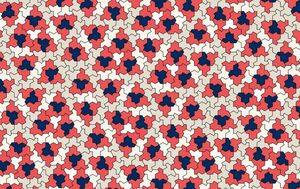
Mathematicians Excited About New 13-Sided Shape Called 'the Hat'
"Researchers proved the existence of a kind of shape that'd only been predicted to exist by theory. For some, tiles are rarely thought of unless it’s time for home renovations, but for mathematicians, they present plenty of conundrums—and a clever team has just cracked a particularly tricky one. Researchers identified a shape that was previously only theoretical: a 13-sided configuration called “the hat” that can tile a surface without repeating. The hat is what’s known as an aperiodic monotile, which means that a single shape can tile a surface without any translational symmetry, or without its pattern ever repeating. The famous Penrose tilings are an example of aperiodic tiling, where the pattern is aperiodic but uses two different shapes. The hat tiling only uses one shape, an “einstein,” which is German for “one stone,” making the pattern an aperiodic monotile." [...]
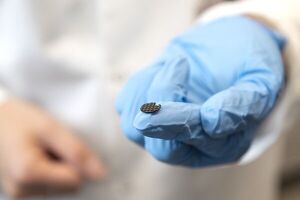
UTEP Joins Project to 3D Print Batteries from Lunar and Martian Soil
"The University of Texas at El Paso has joined a project led by NASA to leverage 3D-printing processes with the aim of manufacturing rechargeable batteries using lunar and Martian regolith, which is the top layer of materials that covers the surface of the moon and Mars. “UTEP is a national leader in additive manufacturing for space applications,” said Kenith Meissner, Ph.D., dean of the UTEP College of Engineering. “I congratulate the team of UTEP researchers involved in this important work. I am confident their work will add significant value to this project, getting us closer to a return to the moon and our first forays beyond.” UTEP’s $615,000 grant is part of a $2.5 million project that includes Youngstown State University (YSU), 3D printer manufacturer Formlabs, as well as ICON, the private sector company currently leading the NASA Mars Dune Alpha project aiming to 3D print future habitats on Mars. The long-term goal of the project is to maximize the sustainability of astronauts' future lunar and Martian missions by reducing payload weight and dead volume. The utilization of local resources widely available on the moon or Mars is crucial to develop infrastructure such as habitation modules, power generation and energy storage facilities." [...]
Documentação
A documentação é parte essencial do processo de aprendizagem e a Internet além de artigos interessantes de explorar também tem alguma documentação em formato PDF interessante de ler. Todos os links aqui apresentados são para conteúdo disponibilizado livremente pelo editor do livro.
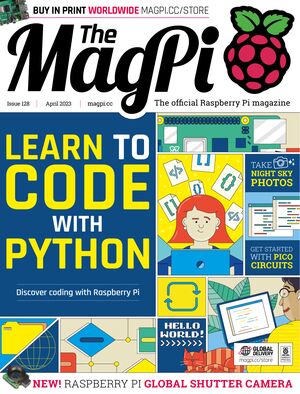
The MagPi 128
"Learn to code with Python. Discover the art of coding with Raspberry Pi Astrophotography. Point your Raspberry Pi and camera to the night sky. Build a machine-learning transcriber. Use ML technology and build a voice-to-text transcriber. Make a DIY binary clock." [...]

HackSpace magazine #65
"With enough inspiration, the world is your playground – that’s why this issue we’re bringing you 16 of the best DIY toys and games to keep boredom at bay. - Get started with surface mount soldering - Make Islamic-inspired geometric LED patterns - Building an aeroplane powered by the super duper supercapacitor - Drool over the finest 3D printed guitar we’ve ever seen" [...]
Projetos Maker
Diversos Projetos interessantes.

Power Deliverer with Current Monitor
"This is an update to my earlier Power Deliverer project to add a current monitor that gives a continuous display of the current consumption. The Power Deliverer allows you to use a USB-C power adapter as a power supply with a range of fixed voltages. It displays a list of the voltages and currents available from the adapter and allows you to select one. Once you've selected a voltage option, it monitors the current consumption and shows it on the display. It's based on an STUSB4500 integrated circuit, an ATtiny1604 microcontroller, and an INA181A2 current monitor, and it displays the information on a 128x32 OLED display. Introduction In my original Power Deliverer project I suggested a possible extension which would add a current sensor, to allow you to show an active display of the current being drawn by the load." [...]
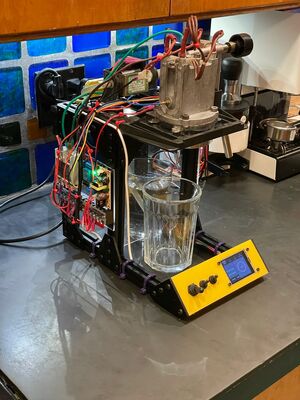
Espresso and open source hardware?
"Why? I love well made espresso. It’s one of my favorite things to look for when I travel, and my social world revolves around cafes. The centerpiece of any café is the espresso machine. They are complicated, mysterious, hard to maintain, and very, very expensive. Who wouldn’t want to bring that experience home?" [...]

Ultracompact minimalistic 6809 Computer V2
"A working 6809 Computer on a 5x5 cm PCB that could fit on your keychain ( and even has a hole for that :) ) This is version 2 that fixes some issues of the first version. A tiny and minimalistic 6809 board that is mostly based on designs and ideas from Jeff Tranter, Dave Collins and Grant Searle. To fit this into 5x5 cm i used a 6 layer PCB as JLCPCB offers them in a promo for no additional cost compared to 4 layers at the moment of writing this, including free filled and plated vias and gold plating. This allows via in pad placement to save space. The top layer is a solid ground plane and layer 5 is a solid 5v plane leaving 4 planes for routing. Parts were mostly selected based on what JLCPCB had in stock and could populate, as hand soldering the tiny smd parts would be a hard job." [...]
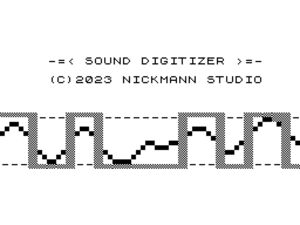
SINCLAIR ZX81 Sound Digitizer
"I wrote the original source code of my now published program in 1986. I recently found it in one of the old spiral notebooks. I typed it but it didn't work because it has a lot of errors. Unfortunately, I could only find this assembly source, no hex code or BASIC loader anywhere. Maybe I have it on one of my tapes or another notebook. Anyway, I fixed it." [...]

K-type Temperature Sensor is Best
"Because of the digital SPI interface of the sensor, MAX6675 amplifier data decoding is fast and more accurate and have long temp ranges. A K-type thermocouple is a type of temperature sensor that is widely used in industrial applications to measure temperature. It is made up of two different metals, typically nickel-chromium and nickel-aluminium, which are joined together at one end to form a junction. When the junction is exposed to a temperature difference, a voltage is generated, which can be measured and used to determine the temperature. In K Type Thermocouple positive leg is composed of 90% nickel, 10%chromium and a negative leg is composed of 95% nickel, 2% aluminium, 2% manganese and 1% silicon. These are the most common general-purpose thermocouple with a sensitivity of approx 41µV/°C." [...]
Tracking and Search Function with ESP32 and arduino robot
"Design and Building of a Smart Platform with ESP32 Cam to achieve the Mode Tracking for search and Following the Face In this tutorial, we will show you how to achieve the search and follow Mode of the Smart Robot Car and make it follow the target to move forward. For this project apart from ESP32 Cam, we will only need a two (or four-wheeled) robot with appropriate motor drivers and Arduino Uno board. The main objective of this project is to perform detection and tracking of faces from the real-time input video. The tracking of the face is done with the help of Arduino uno microcontroller. The microcontroller arduino is connected to two servo motors and two Drive motors. The servos are centered before tracking begins." [...]

Universal HD44780 LCD interface
"This project provides a universal interface to drive the popular Hitachi HD44780 LCD controller. YALI (Yet Another LCD Interface) is an open-source project to provide a universal interface to drive the popular Hitachi HD44780 LCD controller. This module supports 3.3V and 5V MCUs and hardware development platforms, including Arduino, STM32, PIC, and ESP8266. The hardware module of this project consists of a 74HCT08 CMOS AND gate and a 74HC595 8-bit serial-in, parallel-out shift register. This module uses the MP1540 step-up converter to power the LCD unit connected to the system. The module has the jumper to select 3.3V or 5V DC power input." [...]

How to Make a TV Remote Control Robot Car
"Make Cool TV Remote control car using Arduino and IR Receiver. Hey Guys, welcome to my article. So guys today we are going to make a TV Remote Control Robot Car. Project Information: The project makes use of an IR receiver to receive the signal from our TV remote and then, as per the command received from the remote, the car performs the task. For example, when I click my remote’s forward button, the car moves in the forward direction and vice-versa. Materials Required - Arduino nano - IR Receiver kit - Chassis Project Sheet - L298N motor driver - Bo Motor (4x) - Rubber wheel (4x) - Jumper wire - 18650 battery - 18650 battery holder" [...]

GREEN LANTERN With Reed Switch
"Hey everyone, what's up? Now here's something very cool: a completely handmade green lantern lantern. It makes use of an Attiny85 connected to 20 WS2812 LEDs whose color is changed by a reed switch; when a magnetic field is applied to the reed switch, the color of the LEDs changes. The sole objective of this project is to test an idea: what would happen if we placed a magnet inside a 3D-printed ring and used a reed switch to change the color of the LEDs when the reed switch detected a magnetic field? This Instructables is about the whole building process of this project, so let's get started. Material Required Following were the materials used in this built- - CUSTOM PCBS - REED SWITCH - ATtiny85 - IP5303 - 1uF Capacitors - WS2812 LEDs - smd lithium cell holder - 18650 cell A reed switch is an electrical switch that is operated by a magnetic field." [...]
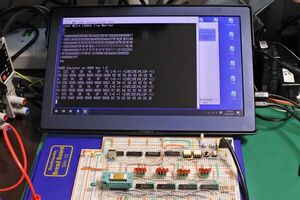
emu8080on4004
"Intel 8080 Emulator on 4004 Evaluation Board A self-made 4004 experimental board and an 8080 emulator running on it. We have achieved a level of functionality that allows Palo Alot Tiny BASIC to operate almost as it is. Restrictions, etc. - The P (parity) flag is not implemented by default. It can be changed with the assemble option, but the operation is unconfirmed. - The DAA instruction is also not implemented." [...]

ESP8266 Word Clock on 16x16 Led Matrix
"Word Clock is a special type of clock where the current time is highlighted within a set of words that can tell any possible time. Word Clock is a special type of clock where the current time is highlighted within a set of words that can tell any possible time. There are many projects for making such a clock with microcontrollers, and usually the most difficult part to make is the "display", which consists of a large number of LEDs, many connections and wires from the LEDs to the controllers, and finally the mechanical performance of the case. This time I will present you a very simple way to make such an interesting clock, where a ready-made led matrix is used as a display. The code is taken from printables.com where you can also download.stl files for 3D printed layout of the letters, as well as parts for the complete case. (https://www.printables.com/en/model/270025-word-clock-based-on-led-matrix)." [...]

Web Controlled Desk Lamp With XIAO ESP32 C3
"Greetings, So this is the WEB Desk Lamp made from PCBs, a unique and innovative DIY project that combines electronics and home automation. The lamp can be controlled remotely through a web server, allowing users to turn it on and off using a smartphone or computer. The lamp is built with printed circuit boards (PCBs), which provide a strong and compact framework for the electronic components. It operates on Seeed's XIAO ESP32 C3 DEV Board, which controls a mosfet that drives ten 0.5W LEDs. This project is a great way to learn about electronics, programming, and home automation. This Instructables will explain how this project was made and how you can create it in a few simple steps, so let's get started." [...]
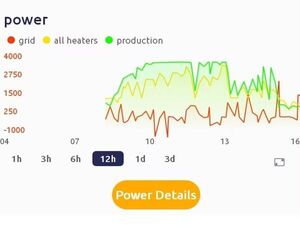
Maximize your solar to keep your home warm
"Automatically feed all excess solar energy, and only excess, into existing electric heaters. Your solar installation may send energy to the power company. When you add solar to your grid-connected home, with the intend to consume your own production (i.e. self consumption), you will quickly realize that any solar energy not consumed by your home will go to the grid. This is called “injecting”, or “exporting”. The energy injected is called “surplus” or “excess” solar." [...]

How to Find Heading Angle from MPU9250 with Raspberry Pico W
"Learn how to make a compass by accurately estimating the heading angle from the MPU9250 magnetometer. The MPU9250 is a compact and versatile motion tracking device that combines a 3-axis accelerometer, 3-axis gyroscope, and 3-axis magnetometer into a single package. Its on board magnetometer can be used to estimate the "heading" angle. Heading angle, also known as azimuth, refers to the direction in which an object or person is pointing or facing, relative to a reference direction, typically north. It is usually measured in degrees, with 0 degrees indicating a direction pointing towards true north, and 90 degrees, 180 degrees, and 270 degrees indicating east, south, and west, respectively. The heading angle or azimuth can be determined using readings from a magnetometer with other calibration techniques to accurately estimate which way the north pole is." [...]

German Board Game: Mensch rgere Dich Nicht
""Mensch rgere Dich nicht!" is a popular German board game that I always used to play with my family. My idea was to make this traditional game interactive with a gesture sensor, servos, sound and LED strips. By pressing the red button you start the game and LEDs turn green. To take out the game pieces you can open the drawer. To close it, you have to swipe above the gesture sensor (from left to right)." [...]

Custom Designed Breadboard Power Module
"My version of the breadboard power module. Optimised for what I need, without any unneeded components. Breadboard Power modules are nothing new or exciting at all. I own a few commercial ones, and they are usually quite similar. They can be picked up for a few bucks and usually do what they are supposed to do, providing power to a project on a breadboard. I decided to do my own version of one of these, as there were quite a few irritating flaws on all of the commercial versions that I have purchased over the years." [...]
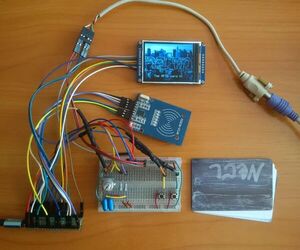
Midbar (Raspberry Pi Pico Version) V2.0
"As I've mentioned in the previous tutorials, with the development of cryptanalysis and new hacking techniques, the cost of accessing your data without your authorization continues to decline, making it easier and more attractive for different sides to get it. I'm not going to get into details about the motivation of each side and the goals they're trying to achieve by obtaining your data. Instead, I would like to focus on the solution to that problem. In my opinion, the only way to keep your data private is to raise the costs of unauthorized access to it as high as possible, ideally higher than any reward that a third side can get by obtaining your data. Doing so puts away the incentives to access your data without your permission. To raise the cost of unauthorized access to your data - I've developed Midbar (which later on "evolved" into a multi-user Cipherbox, and then it kinda turned back into Midbar because I realized that a "multi-user Midbar" is superfluous and not as stable as a single-user one)." [...]
Secção Videos
Videos interessantes.
That's all Folks!





